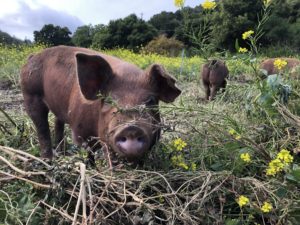
Summary:
Hidden Villa is an organic farm. Organic methods include the use of cover crops and help from farm animals, like piglets, to replenish the soil with lots of nitrogen and other nutrients that plants can access.
Know-It-All
Now that you have watched this video about Nitrogen Fixation with the help of Cover Crops and Piglets, let’s focus on some questions below. Some of these questions have more than one correct answer and some of them will really make you think!
- How do cover crops store the nitrogen from the air?
- Which of these organisms plays an important role in changing the form of nitrogen in the soil?
a) Birds
b)Reptiles
c)Bacteria
d) Fish
3. About how much of the air around us is made up of Nitrogen?
a) 10 %
b) 50 %
c) 2%
d) 80%
4. How do piglets help farmers transfer nitrogen from the plants’ roots into the soil to nourish future crops?
5. Write a list of the things you eat that come from a farm. Remember to include plant AND animal products. You can stop when your hand gets tired.
Digging Deeper
Check out the link below to learn about the farm ecosystem:
https://www2.kenyon.edu/projects/farmschool/nature/ecosys.htm
Eve and Sophie explained how piglets help release the nitrogen stored in the roots of the cover crop into the soil. What other things do you think that the pigs can help us with on the farm? What about all of our other farm animals? (chickens, cows, goats and sheep). Have a conversation with a friend or family member, and see how many ways you can think of that these animals make peoples’ lives better. Thank you, animals!
Hidden Villa is a small, organic farm that raises a wide variety of plants and animals for food. A lot of America’s food comes from really big farms that specialize in one or two crops or one type of animal, like a corn farm or a pig farm. While these farms can produce a lot of food, big farms that grow a limited variety of crops often have negative impacts on the environment.
Until about a hundred years ago, the United States used to consist of many small farms meant to feed small communities nearby. Indigenous peoples of the land, often referred to as ‘Native Americans’, have also tended the land for a very long time, and have grown food on a small scale that has not significantly depleted the Earth’s resources. If you want to dig deeper into farming and agriculture, you can start by following the link below and then we encourage you to do some of your own research and investigation!
https://kids.britannica.com/kids/article/agriculture/352715
Try It
Now let’s get creative! We hope you try out some of the fun and educational activities below related to farming.
A) Pretend you are a farmer and design your ideal farm. You can have whatever farm animals you like, but remember that having lots of animals and crops is a lot of work! Get some paper and draw out what the farm would look like and where all the animals would live. Where is your farm located? What’s it called? Get creative and send us a picture of what you come up with when you’re done!
B) Before your food arrives at the grocery store, it has to be grown or made somewhere. Go to your kitchen and read the labels on the foods you eat. Is there anything that comes from a farm that surprised you (maybe something you can’t pronounce)? What are the foods you’re eating made up of? What part of the world do the foods come from?
C) Interview a farmer: Have you ever met a farmer? Think about how much food you have eaten that comes from farms! Life as we know it would be very different without farmers in it, yet some of us have never even talked to the farmers who grow our food! Ask someone at home to bring you to a farmers market and interview a farmer. Here are some questions you can ask, but we encourage you to come up with your own as well.
- Why did you become a farmer?
- Do you like farming? Is it worth the hard work?
- What is the hardest thing about farming?
- What is the best thing about farming?
- Do you just grow fruits and vegetables? Do you use any farm animals to help you on the farm? Why or why not?
Print out the guide by downloading the PDF
